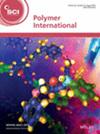Bohdan Murashevych, Dmitry Girenko, Dmytro Stepanskyi, Iryna Koshova, Nikolay Toropin, Konstantin Burmistrov
求助PDF
{"title":"Influence of synthesis conditions and raw materials on the properties of N-chlorosulfonamides immobilized on granular styrene–divinylbenzene polymer carriers","authors":"Bohdan Murashevych, Dmitry Girenko, Dmytro Stepanskyi, Iryna Koshova, Nikolay Toropin, Konstantin Burmistrov","doi":"10.1002/pi.6649","DOIUrl":null,"url":null,"abstract":"<p>Polymer materials with immobilized functional groups–donors of active chlorine are widely used to create products with a microbiocidal effect and increased resistance to microbial contamination. In this work, various methods for the synthesis of granular styrene–divinylbenzene polymers with <i>N</i>-chlorosulfonamide groups were investigated. It has been shown that the synthesis of polymers with chlorine-active <span></span>SO<sub>2</sub>NNaCl groups from a non-functionalized styrene–divinylbenzene polymer matrix through the stage of its sulfochlorination with chlorosulfonic acid in dichloromethane for 6–7 h is optimal. These products contain approximately 11% of active chlorine and maintain a stable particle size distribution. When cation exchangers such as Purolite C100 are used as the initial polymer carrier, the content of chlorine-active groups in the target product is approximately 9%, and an increase in the content of the dust fraction is observed. The obtained samples, regardless of the synthesis method, are capable of releasing active chlorine into solutions containing amino compounds. The microbial impurities in water also cause the emission of active chlorine in an amount that does not depend on the loading of the polymer, but is determined by the concentration of microbes, due to which a pronounced antimicrobial effect is observed. In this case, the resulting products do not cause further decomposition of the functional groups of the polymer, which indicates the high service life of the latter. The availability of raw materials, relative ease of synthesis, stability, possibility of regeneration and microbiocidal properties of the studied polymers make them promising for use as components of water and air purification systems and other products for medical and industrial purposes. © 2024 Society of Chemical Industry.</p>","PeriodicalId":20404,"journal":{"name":"Polymer International","volume":"74 1","pages":"28-36"},"PeriodicalIF":2.9000,"publicationDate":"2024-05-15","publicationTypes":"Journal Article","fieldsOfStudy":null,"isOpenAccess":false,"openAccessPdf":"","citationCount":"0","resultStr":null,"platform":"Semanticscholar","paperid":null,"PeriodicalName":"Polymer International","FirstCategoryId":"92","ListUrlMain":"https://onlinelibrary.wiley.com/doi/10.1002/pi.6649","RegionNum":4,"RegionCategory":"化学","ArticlePicture":[],"TitleCN":null,"AbstractTextCN":null,"PMCID":null,"EPubDate":"","PubModel":"","JCR":"Q2","JCRName":"POLYMER SCIENCE","Score":null,"Total":0}
引用次数: 0
引用
批量引用
Abstract
Polymer materials with immobilized functional groups–donors of active chlorine are widely used to create products with a microbiocidal effect and increased resistance to microbial contamination. In this work, various methods for the synthesis of granular styrene–divinylbenzene polymers with N -chlorosulfonamide groups were investigated. It has been shown that the synthesis of polymers with chlorine-active SO2 NNaCl groups from a non-functionalized styrene–divinylbenzene polymer matrix through the stage of its sulfochlorination with chlorosulfonic acid in dichloromethane for 6–7 h is optimal. These products contain approximately 11% of active chlorine and maintain a stable particle size distribution. When cation exchangers such as Purolite C100 are used as the initial polymer carrier, the content of chlorine-active groups in the target product is approximately 9%, and an increase in the content of the dust fraction is observed. The obtained samples, regardless of the synthesis method, are capable of releasing active chlorine into solutions containing amino compounds. The microbial impurities in water also cause the emission of active chlorine in an amount that does not depend on the loading of the polymer, but is determined by the concentration of microbes, due to which a pronounced antimicrobial effect is observed. In this case, the resulting products do not cause further decomposition of the functional groups of the polymer, which indicates the high service life of the latter. The availability of raw materials, relative ease of synthesis, stability, possibility of regeneration and microbiocidal properties of the studied polymers make them promising for use as components of water and air purification systems and other products for medical and industrial purposes. © 2024 Society of Chemical Industry.
合成条件和原材料对固定在苯乙烯-二乙烯基苯颗粒聚合物载体上的 N-氯磺酰胺性质的影响
具有固定官能团-活性氯捐赠者的聚合物材料被广泛用于制造具有微生物杀灭效果和增强抗微生物污染能力的产品。在这项工作中,研究了合成带有 N-氯磺酰胺基团的粒状苯乙烯-二乙烯基苯聚合物的各种方法。结果表明,在二氯甲烷中用氯磺酸对苯乙烯-二乙烯基聚合物基体进行 6-7 小时的磺酰氯化反应,从而从非官能化的苯乙烯-二乙烯基苯聚合物基体中合成出带有氯活性 SO2NNaCl 基团的聚合物的效果最佳。这些产品含有约 11% 的活性氯,并能保持稳定的粒度分布。当使用阳离子交换剂(如 Purolite C100)作为初始聚合物载体时,目标产品中的氯活性基团含量约为 9%,同时可观察到粉尘部分的含量有所增加。无论采用哪种合成方法,获得的样品都能将活性氯释放到含有氨基化合物的溶液中。水中的微生物杂质也会导致活性氯的释放,其释放量不取决于聚合物的负载量,而是由微生物的浓度决定,因此可以观察到明显的抗菌效果。在这种情况下,生成的产品不会导致聚合物官能团的进一步分解,这表明聚合物的使用寿命很长。所研究的聚合物原料易得、合成相对容易、稳定、可再生,而且具有微生物杀灭特性,因此很有希望用作水和空气净化系统以及其他医疗和工业产品的成分。© 2024 化学工业协会。
本文章由计算机程序翻译,如有差异,请以英文原文为准。

 求助内容:
求助内容: 应助结果提醒方式:
应助结果提醒方式:


